Fallout: Spies, Superbombs, and the Ultimate Cold War ShowdownDecember 2022
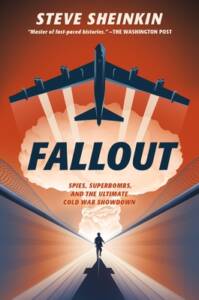
Sheinkin, Steve. Fallout: Spies, Superbombs, and the Ultimate Cold War Showdown. Roaring Brook Press: New York, 2021.
This history of the Cold War reads like a novel (but you can’t make this stuff up) and focuses on the main players at various crisis points in the era. From post-WWII spy trade to prisoner swaps to the Cuban Missile Crisis and the Berlin Wall, it’s all thrilling. Includes photographs, source notes, bibliography, and index.
It’s a must-have for any school serving students Grade 7 and up. Would also recommend to adults who will appreciate the overlap with other books and movies.
Dewey: 972.9106 Interest Level: Grades 6 – 12
Awards and Reviews: ALA Notable Children’s Books; Booklist starred, Bulletin of the Center for Children’s Books starred; Horn Books starred; Kirkus Reviews; New York Times; Publishers Weekly starred; Sibert Award, 2022; School Library Journal starred.
Younger readers might like: Cold War Correspondent (Nathan Hale’s Hazardous Tales, Book 11) by Nathan Hale
Fiction pairing: A Night Divided by Jennifer Nielsen
On the web: Find details on virtual tours of the Spy Museum!
Watch: Bridge of Spies (2015) from Stephen Spielberg. Rated PG-13.
Nonfiction Book Archives
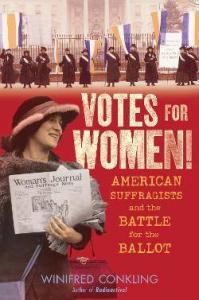
Chapel Hill, North Carolina: Algonquin Young Readers, 2018
Conkling, Winigred. Votes for Women: American Suffragists and the Battle for the Ballot. Chapel Hill, North Carolina: Algonquin Young Readers, 2018.
Just in time for Women’s History Month in March comes Votes for Women, a history of suffrage in the United States, told from the points of view of the women who led the 78-year struggle resulting in the 19th Amendment. Conkling tells the stories of the likes of Elizabeth Cady Stanton, Susan B. Anthony, Lucy Strong, Sojourner Truth, and Victoria Woodhull, among others, in a more complete context than some other titles on women’s suffrage. Conkling writes about them as real people dealing with the pressures of family life and contemporary social norms while working for their cause among the competing priorities of temperance and emancipation.
Students might be shocked to learn that in the mid-19th century, women living in the land of the free were not legally entitled to own property. The could not keep their own wages, vote for their government representation or laws, or conduct their own business. Even public speaking was off-limits until suffragists broke the mold.
Conkling skillfully introduces the players, seamlessly plugging them into the narrative and changing points of view as they enter the stage. There are detailed captions with photographs of key players throughout this book. Examples of political cartoons, posters, lithographs, and more are included throughout. Resources at the end include a list of Key Primary Sources, a timeline, books as sources and additional reading, websites, and extensive notes. This is a must-have for middle school and high school collections, and is suitable for research and reports. Conkling has produced the sort of top-notch nonfiction that students and teachers alike will want to read.
Dewey: 976 Interest Level: Grades 7-12
Reviews and Awards:
Kirkus Reviews starred, Publishers Weekly starred, School Library Journal.
Younger readers might like: The Taxing Case of the Cows: A True Story About Suffrage by Iris Van Rynback, (illus. Emily Arnold McCully).
Middle grade readers might like: Suffrage Sisters: The Fight for Liberty by Margaret R. Mead, (Illus.) Siri Weber Feeney. (Reader’s theater format).
Fiction paring: The Cure for Dreaming by Cat Winters
On the Web:
When American Feminists Were Pilloried for Daring to Wear Boomers. Atlas Obsura athttps://www.atlasobscura.com/articles/when-american-feminists-were-pilloried-for-daring-to-wear-bloomers.
Library of Congress Primary Source Set: Women’s Suffrage. Primary sources, LOC-style athttp://www.loc.gov/teachers/classroommaterials/primarysourcesets/womens-suffrage/
National Constitution Center – Clear explanations and debate on the origins and effects of the Constitution and its Amendments. Find it at https://constitutioncenter.org/.
The American History Museum website has images of artifacts from the fight for women’s suffrage athttp://americanhistory.si.edu/treasures/womens-suffrage.
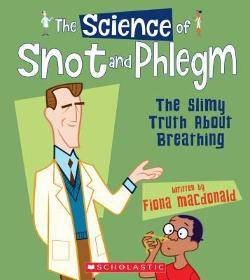
Brighton, UK: Franklin Watts, an imprint of Scholastic, 2018
Finally! A book for elementary students with a scientific reason not to pick your nose, with lots of other snotty facts and information. MacDonald lays out the story about mucus, colds, allergies, and all things stuffy-nosed into large print paragraphs. She packs even more information into dialogue boxes, side bars, and labeled illustrations. Funny captions (What does snot say about you?) keep the pages turning and the mucus flowing.
Fans of gross stuff will love the “Disgusting Data” boxes sprinkled with “Fascinating Facts” and dialogue boxes from a diverse group of doctors throughout. Some of the double-page spreads seem a bit too cluttered, but those who like a very full look will be satisfied with all the different elements to look at on a page.
The Science of Snot and Phlegm is one of the Series of the Body set, which includes The Science of Acne and Warts: The Itchy Truth About Skin; The Science of Poop and Farts: The Smelly Truth About Digestion; and The Science of Scabs and Pus: The Sticky Truth About Blood. This set might be a good humorous addition to an elementary school collection with a solid collection of human body books. It could also be a good option for those hard-to-find books with subject matter that advanced younger readers will find interesting. Includes a Glossary and an Index.
Dewey: 612.2 Interest Level: Grades 3-6
Reviews and Awards: None.
Younger readers might like: Boy Were We Wrong About the Human Body by Kathleen V. Kudlinski (illus. Debbie Tilley).
Middle school readers might like: Understanding the Brain (Amazing Human Body series) from Enslow Publishing.
Older students might like: Human Movement: How the Body Walks, Runs, Jumps, and Kicks by Carla Mooney (illus. Samuel Carbaugh).
Fiction pairing: Frankenstein: Retold from the Mary Shelley Original by Deanna McFadden (Illus. Jamel Akib).
On the Web: LiLI.org: World Book Student – The Human Body.

New York: NorthSouth Books, Inc., 2017
The illustrations are the star in the sweet biography picture book of Frida Kahlo – they are vibrant, clean, and reminiscent of Kahlo’s color pallet. Except maybe the spider monkeys. Those guys are a little bit half-monkey-half-man creepy.
Some biographies move from life event to life event, highlighting things that happened either to the subject or because of him/her. This one flows through Kahlo’s life, revealing character traits by using similar traits in Kahlo’s pets. Frida has long, dark hair, and is playful, like her cat. We learn that there is an accident, an illness, and a marriage, but the story is really about the things in Frida’s life that she loved: her home, her heritage, her pets, her art, and her family.
The author’s note is quite long and has details about the artist for those who are interested in learning more. There are lots of biographies available about Frida Kahlo, but this one is a lovely take on her life through her love for her pets. It would make a good supplemental addition to an elementary biography section. Bonus: this title is available in Spanish!
Dewey: 759.973 Interest Level: K-3
Reviews and Awards: Booklist, Kurkus Reviews, Publishers Weekly, School Library Journal.
Middle grade students might like: Frida Kahlo: The Artist in the Blue House by Magdalena Holzhey
Older Readers might like: Frida Kahlo’s Wardrobe by Claire Wilcox
Fiction Pairing: Maybe Something Beautiful: How Art Transformed a Neighborhood by F. Isabel Campoy and Teresa Howell. Illustrated by Rafeal Lopez
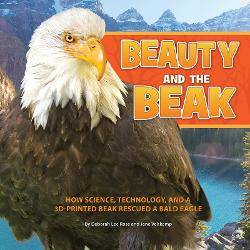
Apex, NC: Persnickety Press, 2017
It is always exciting to find a book with an Idaho connection! This one is full of interesting facts about the life of a bald eagle, conservation resources, and links to educational materials that don't disappoint. (Warning: the Eagle Cam Live Feed is a bit addictive.)
Beauty and the Beak is the story of one particular Alaskan bald eagle who had her beak shot off by a poacher. She was found by a police officer and taken to a wildlife center, where she met one of our authors, Janie Veltkamp. Veltkamp, a raptor biologist, runs Birds of Prey Northwest, a raptor center in North Idaho near Lake Coeur d'Alene. She took the injured eagle, by then named Beauty, home to Idaho, and made a plan for her healing and recovery. Soon she put together a team that would work to print and fit Beauty with a prosthetic beak.
This is a moving story that incoprorates the conservation success story of the bald eagle, the challenges that all raptors face in our world, and Beauty's happy ending. There are clear, daramatic photographs of bald eagles at various stages of development from eaglet to adult, and then of Beauty being fitted with her new beak.
The back matter in Beauty and the Beak is almost better than the story, although the text becomes more dense and complex. Teachers and librarians using this for classwork, and students using it for research will find the text full of useful informtion. Use of more graphic representation (like a diagram of the anatomy of an eagle, or a map representing the population density of eagles in North America, for instance) might have made this book even better.
The Education Guide and other teacher resources that come with this title are quite good and give students and educators alike lots of options for finding more information. There is even an .stl file to 3-D print Beauty's beak available. Be sure to download the QR Code reader to use the codes in the back of the book. Birds of Prey Northwest visits schools, libraries, and other groups (including library conferences) with their captivating program featuring live birds of prey. Nothing raises goosebumps like making eye contact with an eagle!
This title is a must-have, especially for Idaho elementary and middle school libraries, particularly when paired with the other educational resources that go with it.
Dewey: 598.9 Interest Level: Grades 3-6
Reviews and Awards: Booklist, Kirkus Reviews, Publishers Weekly, School Library Journal
Younger readers might like: Bald Eagle by Gordon Morrison
Older Raders might like: Silent Spring by Rachel Carson
Fiction Pairing: My Side of the Mountain by Jean Craighead George or The Evolution of Calpurnia Tate by Jacqueline Kelly.
On the Web:
Birds of Prey Northwest in North Idaho is Beauty's home. Visit this site for information on bringing birds of prey to your school.
The World Center for Birds of Prey is located in the Treasure Valley. This website has an Exploring Raptors section like "find a raptor," and help identifying raptors by their silouette, along with the characteristics that make a bird a raptor. There is also information about programming available through the Peregrine Fund.
Intermountain Bird Observatory at Boise State University holds bird banding events for many species of birds.
Bird Cams from Audubon and the Decorah Eagle Cam are so fun to watch!
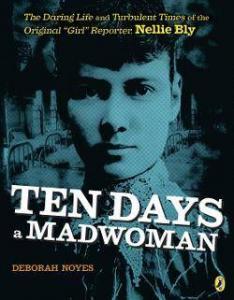
New York: Viking, 2016
In a time when American women had few choices and little control of their futures, Elizabeth Jane "Pink" Cochran, better known as Nellie Bly, made things happen. She is an excellent example of grit, tenacity and courage, even for modern students. Nellie made a name for herself as a so-called "stunt reporter," going undercover to get the real story. Not considered a great writer at the time, she was a gifted interviewer with a talent for telling a personal story to get to the heart of a matter. Her best reporting exposed curruption, abuse, and neglect, and told the stories of those unable to tell their own. Her gender may have made it difficultto get a serious reporting job in New York, but once she managed to get the job, it proved to be a real asset. No one suspected the small, pretty, young woman of being a serious undercover reporter. She was a pioneer of investigative journalism.
Noyes titled her book Ten Days a Madwoman, referring to Nellie's first big undercover job at the infamous insane asylum for women on Blackwell's Island in New York. The first half of the book focuses on Nellie's efforts to get into the asylum, her experience there, and her reporting afterward. The second half is about some of her adventures during the rest of her life, including her trip around the world in 72 days (quite a feat in 1889!).
Blue pages in the book take us to flashbacks, asides, and interesting information about Nellie and her times, like how she adopted Nellie Bly as her pen name. The blue pages add depth and color to the book, already rich with illustrations, photographs, engravings and newspaper images. Throughout the book we encounter history-makers of the time like Jules Vern, Susan B. Anthony, Emma Goldman, and Joseph Pulitzer. With extensive source notes, a bibliography including further reading and websites, picture credits, and a detailed index, Ten Days a Madwoman would be an excellent addition to any middle school or high school nonfiction collection.
Dewey: 070.92 Interest Level: Grade 6 and up
Reviews and Awards: Booklist, Horn Book Guide, Horn Book Magazine, Kirkus Reviews, Publishers Weekly, School Library Journal starred, Voice of Youth Advocates (VOYA).
Younger readers might like: The Daring Nellie Bly: America's Star Reporter by Bonnie Christensen.
Middle grade readers might like: Bylines: A Photobiography of Nellie Bly by Sue Macy.
On the web:
Nellie Bly: The Pioneer Woman Journalist - A Resource Website at http://www.nellieblyonline.com/. Find some actual articles that Nellie wrote, a photo gallery, links to additional websites and more.
Video: American Experience: Around the World in 72 Days DVD from PBS. Available at https://shop.pbs.org/american-experience-around-the-world-in-72-days-dvd/product/WG40109.
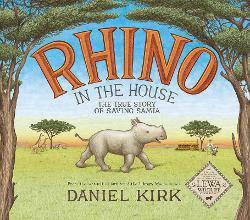
New York: Abrams Books for Young Readers, 2017
Anna Merz, a wildlife conservationist, thought she was retiring to Kenya - she half right. When she arrived in Kenya, it was to discover that poachers were killing rhinos for their horns and set about establishing a preserve for the endgangered animals. One day Anna found a small calf whose mother wasn't caring for it, and knew it would not survive without help. So she took the calf home, and named it Samia. This is their sweet story.
Rhino in the House is thoughtful and fun, and author/illustrator Daniel Kirk manages to make a baby rhino adorable, but still realistic. That doesn't seem easy. Throughout, this book is a stright-forward, yet simply and gently told account of an extraordinary friendship. The charming illustrations show Anna reading to Samia in bed, Samia eating a hat and trampling the garden, and the two of them enjoying walks together. Kids will laugh at the antics, and those who care for pets at home may relate to the effort it would take to care for a rhino and teach it how to survive.
While the illustrations themselves are just lovely, there's more. The photographs in the Author's Note section include wonderful scenes from the author's trip to Kenya, Anna's home there, and a gem of a photo of Anna and Samia. Also included are maps, and a bibliography. Rhino in the House would make a fine addition to any elementary school collection and would be appreciated by independent readers and story-time participants, alike.
Dewey: 599.66 Interest Level: PreK-3
Reviews and Awards: Booklist, Kirkus Reviews, Publishers Weekly Annex, School Library Journal.
Upper elementary students might like: Animal Scientist and Activist Jane Goodall by Douglas Hustad.
Middle school students might like: Amazon Adventure: How Tiny Fish are Saving the World's Largest Rainforest(Scientists in the Field) by Sy Montgomery. Photographs by Keith Ellenbogen.
Young adults might like: Rhino at the Brink of Extinction by Anna Merz.
On the Web:
Want to really amp up the cute factor? Here is a video of a two-week old rhino born in 2016 in a German zoo at https://www.youtube.com/watch?v=ecqVuo99jfw.
LEWA Wildlife Conservancy: A Unesco World heritge Site since 2013. Learn more about the rhinos and other wildlife that live at LEWA.

New York: Houghton Mifflin Harcourt, 2016
If Some Writer! isn't my favorite book of this school year, it is certainly my favorite children's biography! The challenge here will be limiting the gushing. (But really, so good!) For many, experience with White's work is limited to his writing for kids, and maybe for his work on The Elements of Style. While Some Writer! does give a lot of attention to his work in children's literature, it also dives into his work on books for adults, on poetry, and his life-long career with The New Yorker.
From the very first page, this book is infused with the the warm atmosphere of a happy family. There were surely family squabbles and crises, but White's parents were loving and managed, it seems, to raise seven healthy and productive citizens. The family challenges are presented as the regular type, free of real tragedy and drama. Even the photograph introducing the White family shows a casual family, a departure from the stiff, unsmiling family portraits of the time. The photos, narrative, quotes from White himself, and fun illustrations by the author reveal a happy, if very shy, boy, full of adventure and humor.
Chapters covering White's adult years are organized by his writing projects, so readers get a sense of the context in which his most famous works are written, and the inspiration behind each story. We learn about his wife and children, his fondness for the outdoors and animals, and his philosophy on writing. There is a lot of advice for young writers woven in, for those who are interested.
Sweet's trademark watercolor and collage illustrations are rich and full of interesting details about White's life. With White's hand-written manuscripts and workpapers, his drawings, vintage office suppplies and typewriter keys, along with her own illustrrations, Sweet seems to capture the spirit of White's work. She even makes the chapter on The Elements of Style enjoyable!
Some Writer! has everything a great information text needs: interesting content organized in an engaging format; primary source documents; a timeline; an index; endnotes; and a selected bibliography of White's work and the work of others. There is even an afterward by White's granddaughter.
Put Some Writer! at the top of your nonfiction wish list! It is a must for every school library biography section, and it is one of those books that will be injoyed by readers of every age.
Dewey: 818 or 921 Interest Level: Grades 3-6 and beyond
Reviews and Awards: Booklist starred; Bulletin of the Center for Children's Books starred; Hornbook Magazine starred; Kirkus Reviews starred; New York Times; Publishers Weekly starred; School Library Connection starred; School Library Journal starred; Booklist Editors' Choice: Books for Middle Readers 2016; Notable Children's Books, 2017 for All Ages; Orbis Pictus Award Winner, 2017.
Middle School readers might like: E.B. White by Deb Aronson
Young Adult readers might like: Essays of E.B. White by E.B. White
Fiction Pairings: Charlotte's Web, Stuart Little, and The Trumpet of the Swan, all by E.B. White.
Audio: "How E.B. White Spun 'Charlotte's Web': a review by Maureen Corrigan on NPR's Fresh Air at http://www.npr.org/2011/07/05/137452030/how-e-b-white-spun-charlottes-web. Aired on July 5, 2011.
On the Web:
Robert Angell, "Andy: for E.B. White's readers and family, a sense of trust came easily." New Yorker, February 14, 2005 at http://www.newyorker.com/magazine/2005/02/14/andy.
For more of E.B. White's work at The New Yorker, visit www.newyorker.com and search for E.B. White. There are many articles written throughout his career at The New Yorker.
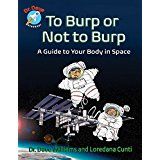
Berkeley, CA: Annick Press, 2016
What is the question most often asked of an astronaut? It is "How do you go to the bathroom in space?" That question, and many more on the subject of bodily functions in space, are answered in To Burp or Not to Burp. This fun book for the elementary set is written by a real astronaut, Dr. Dave Williams, and he answers some very personal questions in a fun, accurate, and matter-of-fact way. It is just gross enough to be funny, has great scientific facts, and an appealing layout that keeps students engaged. Sleeping, eating, peeing, pooping, farting, nose-blowing, and, of course, burping (who knew burping in space could be so risky?) are all covered, along with problems like loss of bone density, working with several sunrises and sunsets during a work day, excercise, and much more.
Kids that are interested in the nitty-gritty details of life in space will like this book, and maybe even the somewhat corny jokes. What's a book about space without an "out of this world" joke, after all? To Burp or Not to Burp includes a table of contents, suggestions for further reading, and a detailed index. There is a great mix of photos, humorous illustrations, and fun facts. It is a good addition to any elementary space collection.
Dewey: 612 Interest Level: Grades 3-6
Reviews and Awards: Booklist, Kirkus Reviews starred, School Library Connection, School Library Journal.
Middle school readers might like: The Coolest Job in the Universe: Working Aboard the International Space Station by Henry M. Holden.
Young Adults might like: 101 Outer Space Projects for the Evil Genius by Dave Prochnow.
Fiction Pairing: Star Seeker: A Journey to Outer Space by Teresa Heine and illustrated by Victor Tavares.
Video: The Magic School Bus: Space Adventures. DVD from Scholastic Entertainment, 2013.
On the Web:
Life in Orbit at http://www.rigb.org/christmas-lectures/teaching-resources/2015-how-to-survive-in-space/life-in-orbit from the Royal Institute has lessons and video for students ages 7-11.
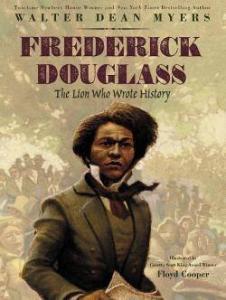
New York: Harper Collins Children's Books, 2017
Walter Dean Myers died in 2014, but he left us another one of his brilliant books for young people. It is not the goal of this picture book biography of Frederick Douglass to tell us his entire life story; rather, it highlights Douglass's decisions through the course of his life that made him a great success and a historical figure. Douglass learned to read in secret, recovered from a broken spirit, learned to write and behave like a free and educated person, ran away, became a public speaker and activist, and served his country not because those things happened to him, but because he made decisions to make them happen.
Important and relevant for today's students is the example set by Douglass in taking control of his life. He made good, if dangerous, choices throughout his life to set himself up for success and took every opportunity to observe and learn. Students might think about decisions they make in elementary, middle, and high school that could make a difference later on.
Cooper's illustrations are as beautiful as one would expect from this award-winning illustrator. The soft tones created by Cooper's eraser and oil technique give just the right soft quality for such a reflective story. With lots of text on the page, this title is best for reading aloud and older elementary students. At the end there is a helpful timeline of Douglass's life, a very short bibliography, and the text of the document signed by Hugh Auld officially and legally freeing Frederick Douglass.
Frederick Douglass: The Lion Who Wrote History is an excellent addition in honor of Black History Month, especially if a more traditional Douglass biography is already in the biography section, and an important picture book biography for any elementary collection.
Dewey: 973.8 or 920 Interest Level: K-4
Reviews and Awards: Booklist starred; Bulletin of the Center for Children's Books; Kirkus Reviews; Publisher's Weekly starred; School Library Journal starred.
Middle school readers might like: Abraham Lincoln and Frederick Douglass: The Story Behind an American Friendship by Russell Freedman.
Young adult readers might like: Unbound and Unbroken: The Story of Frederick Douglass by Amos Esty.
Fiction Pairing: Freedom Over Me: Eleven Slaves, Their Lives and Dreams Brought to Life by Ashley Bryan.
On the Web:
Africans in America Resouce Bank: Frederick Douglass from PBS.org. Includes a summary of Douglass's life and a link to a great Teacher's Guide.
Frederick Douglass National Historic Site District of Columbia from the National Park Service. Website includes video, photographs of Douglass and his family, a collection of items owned and used by Douglas, lesson plans and more materials for classroom use.
Video:
American Experience: The Abolitionists from PBS.
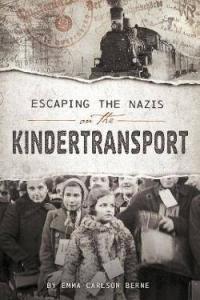
North Mankato, MN: Encounter by Capstone Press, 2017
There are so many resources already available about the World War II era, what more can possibly be written? Escaping the Nazis on the Kindertransport is worth taking a look, especially when looking for a nonfiction WWII title that includes children, where the circumstances are not just too terrible for elementary kids to digest. That's not to say there isn't heartbreak here, there is; but there is hope, too. As Escaping the Nazis begins, the world prepares for war, some Jewish families prepare to get their children out of German controlled parts of Europe, even though they know they might never be together again.
Although Berne covers some dark subject matter here, it is appropriate for upper elementary and middle school students. The book is structured as seven seperate accounts, each focused on a child that escaped on a Kindertransport, with gently, but factually, presented information that makes the stiutaion clear. We learn about the children, their parents, and some of their experience so far with the Nazis. In some ways this book might be more difficult for adults than for kids to read. One can't help but sympathize with parents making the impossible choice of trusting your child to the care of strangers in a far-away country, or keeping them close in terrible danger.
About 10,000 children were taken to England on the Kindertransport. With photographs, narratives, and first-hand accounts, we track seven of them to England. It isn't until the very end of the book that we learn the fates of our seven children and their families, which helps to build some suspense. Berne also includes a fantastic timeline, a glossary, sources for more reading, a bibliography, source notes, and an index, but a few maps showing the routes of the trains would have been helpful.
All in all, this title would make a great supporting player to an elementary or middle school collection with a solid WWII collection. Put it on the wish list.
Dewey: 940.53 Interest Level: Grades 3-6
Reviews and Awards: Booklist; Kirkus Review, Publishers Weekly.
For Young Adult Readers: The Children of Willesden Lane: Beyond the Kindertransport: A Memior of Music, Love and Survival by Mona Golabek.
Fiction pairing: The War that Saved My Life by Kimberly Brubaker Bradley (middle grades) or My Family for the War by Anne C. Voorhoeve (YA).
On the Web:
The Kindertransport Assocation: find inforamtion about the history of the Kindertransport, traveling exhibits, and links to lots of resources.
United Kingdom National Archives: the Education/Classroom Resources section here is overflowing with primary source documents from the government ministries, other organizations and individuals who directed the Kindertransport.
United States Holocaust Memorial Museum: for more information about the Holocaust, including recorded oral histories from an organizer and a refugee from the Kindertransport.
Film: Into the Arms of Strangers: Stories of the Kindertransport. Directed my Mark Jonathan Harris, narrated by Judy Dench, Warner Bros, 2000.
